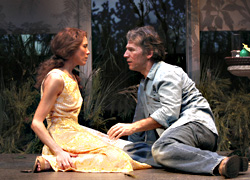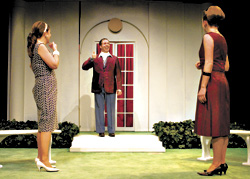In both tenor and trajectory, Amlin Gray’s Obie Award–winning play How I Got That Story falls firmly in the tradition of such absurdist “war is hell” satires as Kubrick’s Dr. Strangelove and Joseph Heller’s seminal novel Catch-22. Set in the fictional Southeast Asian country Ambo Land—a war-ravaged nation strongly resembling the “quagmire” of 1960s Vietnam—this dark, surreal comedy tracks the quixotic progress of a naively idealistic reporter as he seeks to “write what he sees” of combat’s bloody truth. Such truth, as could be expected, is a matter at once complex and contested, and hardly irony-free.
From the opening scenes, as he’s ideologically hazed before receiving his in-country press accreditation, our intrepid Reporter (ArtsWest veteran Paul Custodio) is sent spinning through a violently bizarre series of confounding, corrupting, and generally menacing encounters—mindfuck run-ins with a cast of eccentrics and grotesques ranging from soldiers, guerrillas, and prostitutes to monks, junkies, and the tyran-nical Madame Ng, empress of the besieged Ambo empire. Directed by Andrew Jensen (PileDriver, The True History of Coca-Cola in Mexico), How I Got That Story is an entertaining and often intense journey through a nightmare world of humanity set adrift by international conflict and political subterfuge. If, in the final reckoning, the play proves unsuccessful, the fault rests squarely with the choice of material rather than on those executing it. Gray’s play, written in the early ’80s, seems at once too broad in its condemnation and too specific in its setting to say much about our current state of affairs.
There is nonetheless much to enjoy about this production, not least of which is the work of Nick DeSantis, who plays opposite Custodio and over the course of the play takes on 21 different characters—in a word, all of them. From his opening turn as head of the transnational corporation manipulating media access to the war, to his final showing as a drug-addled, nearly limbless reporter driven insane by his work, DeSantis proves adept at lightning-quick transformations, all of which he nails with confidence. And the crazier the character, the stronger his work: When his Dennis Hopper–like reporter claims to have taken a photo of his own arm being blown off (“It was a little underexposed, but it was out of this world”), DeSantis finds the perfect balance between hilarity and terror. His strongest moment comes in his portrayal of a guerrilla who confronts Custodio’s Reporter on his existential right to cover the war. “We are a spectacle to you. Your standpoint is aesthetic,” he hisses, calling the Reporter’s situation “morbid and decadent . . . bourgeois. . . .” It’s a damning indictment of interventionist politics, harsh and disconcerting, though also too isolated and distinct; Gray should have followed this line of representation to its logical conclusion. Instead, the guerrilla’s just one more type, a caricature inflicting yet another scar on the Reporter’s psyche.
The production itself is delightfully low-tech: Most of the sounds of warfare piped into the theater speakers are created by someone making explosion noises with their mouth, like a kid playing with toy army men. The set is spare and brightly lit, challenging the audience’s imagination; three simple screens, each with one small corner painted suggestively with, for example, brickwork or an Asian symbol, provide interchangeable backdrops for the action. Such abstractions, however, belie the specific setting of the play, which obviously was heavily influenced by Gray’s research on the Vietnam War. How I Got That Story seems to derive from the same epochal concerns that inspired Francis Ford Coppola’s Apocalypse Now; somehow, its message feels dated, anchored to the era of Woodstock and Watergate. And despite the apparent timeliness of a play that takes on the media’s collusion in creating the Orwellian narrative of warfare, the play adds little to that difficult dialogue; it brings no new information to the table. Of course, the same could be said of hundreds of plays that are still regularly produced and deemed viable and timely—this just isn’t one of them.








